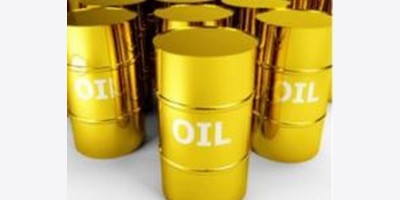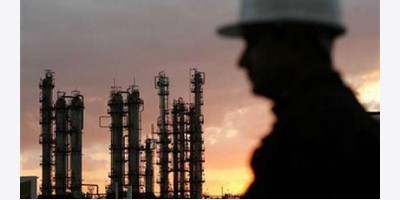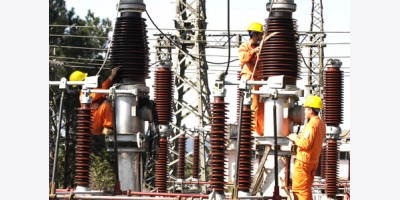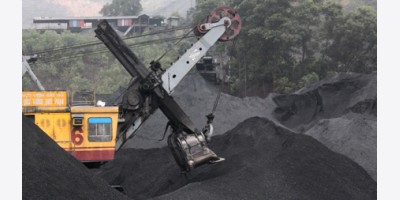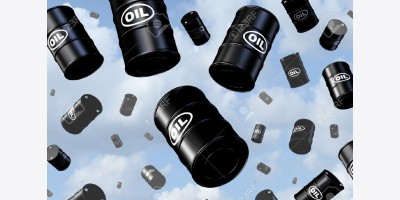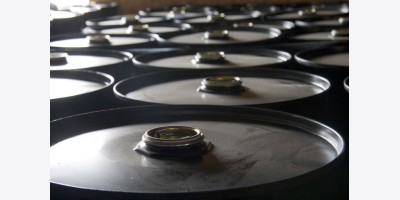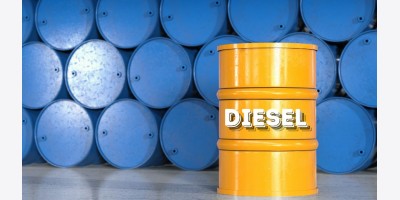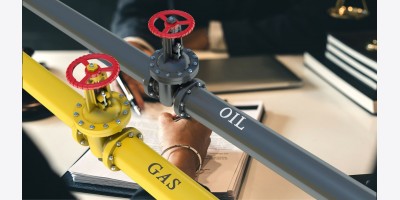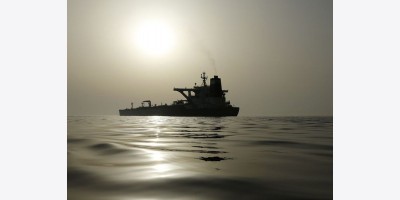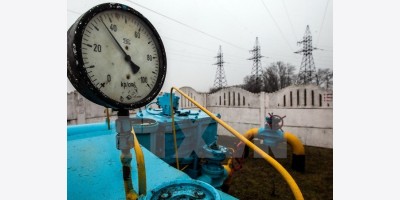By Grant Smith Aug 12, 2014 3:00 PM GMT+0700
Global oil demand growth eased to its weakest since 2012 last quarter, calming world markets amid threats to supplies in the Middle East and North Africa, according to the International Energy Agency.
The IEA cut estimates for oil demand growth this year and next after the annual expansion in fuel consumption slowed to 700,000 barrels a day in the second quarter, the lowest level since early 2012. The resulting supply surplus has meant that Libya, seeking to restore crude exports choked off by political feuding, is struggling to find buyers, the agency said in its monthly market report. Logistical constraints in southern Iraq may prove a bigger hurdle to bolstering output than violence in the north, it said.
“Despite armed conflict in Libya, Iraq and Ukraine, the oil market today looks better supplied than expected, with an oil glut even reported in the Atlantic basin,” said the Paris-based agency, which advises 29 nations on energy policy. “The market appears confident that OPEC can deliver the production increase needed from it to meet rising demand expected in the second half of the year.”
Brent crude futures have declined 6.2 percent this year even as an Islamist insurgency flares in Iraq, tensions escalate between the West and Russia over Ukraine, and Libyan exports remain curtailed as political factions battle for control. Brent was at $104.20 a barrel on the ICE Futures Europe exchange in London today.
Forecasts Lowered
The agency reduced estimates for global oil demand growth in 2014 by 180,000 barrels a day following a weaker assessment of the world economy by the International Monetary Fund. Consumption will increase by 1 million barrels a day, or 1.1 percent, this year to average 92.7 million a day.
While demand growth will rebound next year, the pace will be 90,000 barrels a day slower than previously expected because of lower estimates for China and Russia. Global consumption will expand in 2015 by 1.3 million barrels a day, or 1.4 percent, to 94 million a day. Total demand levels for this year are little changed from last month’s projections, while growth is lower because of upward revisions to consumption data for previous years.
The agency’s outlook for demand in the second half of this year is stronger than previously assessed, meaning the amount of crude required from the Organization of Petroleum Exporting Countries will be 30.8 million barrels a day, higher than last month’s estimate. That’s about 360,000 a day more than the organization pumped in July.
OPEC Rebound
Output from OPEC’s 12 members climbed 300,000 barrels a day in July to a five-month high of 30.44 million a day, as Saudi Arabia raised production and supplies recovered in Libya. The Gulf kingdom, OPEC’s biggest member and de facto leader, increased output to 10 million barrels a day, the most since September, the IEA said. Libyan output almost doubled to 430,000 barrels a day.
“The Atlantic market is currently so well supplied that incremental Libyan barrels are reportedly having a hard time finding buyers,” the agency said. “Many in the market seem more focused today on potential short-term downward price pressures from a further increase in Libyan production.”
Industry oil inventories in developed nations swelled to their highest since September, the agency said. Stockpiles of crude and refined products in the Organization for Economic Cooperation and Development increased for a sixth month in June, by 13.8 million barrels to 2.67 billion, narrowing their deficit to their five-year average.
By Volodymyr Verbyany, Daryna Krasnolutska and Ilya Arkhipov A convoy Russia says is loaded with humanitarian assistance for rebel-held areas of Ukraine headed for the border, as the government in Kiev set conditions for letting the aid in and the Red Cross demanded more details.
Russia’s government said 280 trucks with 2,000 metric tons of donated food, medicine and water left Moscow yesterday and would proceed into Ukraine under the auspices of the Geneva-based International Committee of the Red Cross. Ukraine expressed fears the convoy is carrying military equipment to aid the pro-Russian separatists.
The ICRC needs “some clarification first regarding modalities, practical steps that have to be implemented prior to launch such an operation,” Laurent Corbaz, its head of operations for Europe, said in a video on the Red Cross website. “We seriously need security guarantees, for example, and direct contact with all the parties; this is not settled yet. We need as well to know precisely what is inside the convoy, the size of this convoy, and the various material that is going to be handed over.”
The wrangling over the aid comes as Ukrainian forces tighten a noose around rebel strongholds in the cities of Donetsk and Luhansk, where thousands are without water and power. Ukraine blames Russian President Vladimir Putin for stoking a separatist war that has killed more than 1,200 people in the east after annexing the Crimean peninsula in March.
‘Calculated or Accidental’
“The Russian aid mission raises the prospect of incidents -- calculated or accidental -- that could further escalate the crisis by enabling Moscow to argue that Ukrainian and international organizations are unwilling or unable to provide adequate security,” New York-based Eurasia Group analyst Alexander Kliment said in an e-mail. “This logic would then lead Russia to insert troops under the pretext of protecting aid workers.”
Amid the continued tensions, Ukraine’s currency, the hryvnia, plunged as much as 6.9 percent to a record-low 13.715 per dollar yesterday. The head of the central bank, Valeriya Gontareva, told lawmakers in Kiev the hryvnia dropped after “a mood of panic” spread “because of speculation about the start of a full-scale war.”
Ukraine’s military says it’s near the end of an operation to surround the remaining separatist strongholds and has called on civilians to leave Donetsk and Luhansk. Encirclement of the rebels would shut off routes to the Russian border and sever their supply lines. The Defense Ministry said on Facebook yesterday that government forces retook control of three villages and “neutralized” a group of 30 rebels.
Without Power
A Snapshot of Ukraine's Past and Future
The fighting is causing havoc in the residential areas where it’s now concentrated. Luhansk, where about half of the 500,000 population remains, is completely isolated, with electricity cut off in the center and people without phone connections, food, medication or fuel, the city council said on its website. Many residents have had no power for three weeks and most shops are closed.
Russia’s Foreign Ministry said on its website the white-painted trucks are en route to the frontier between Belgorod and the Ukrainian city of Kharkiv -- about 700 kilometers (430 miles) by road from Moscow.
“We took into account all the wishes of the Ukrainian side on all aspects of the operation,” Russian Foreign Minister Sergei Lavrov told reporters in the Black Sea resort of Sochi yesterday. The trucks will be given Ukrainian license plates when they cross the frontier, he said.
Demands Dropped
Lavrov said ICRC representatives will meet the convoy on the border and inspect the cargo before it travels on initially to the Luhansk region. Ukrainian officials dropped demands to transfer the aid into other vehicles at the frontier, he said.
“Signals” had been sent to the rebels to ensure the safety of the convoy, the foreign minister said.
The Ukrainians “feel comfortable with” the plan for dealing with the aid delivery, U.S. State Department spokeswoman Marie Harf told reporters in Washington.
Valery Chaly, the deputy head of President Petro Poroshenko’s administration, set out Ukrainian demands earlier yesterday, saying that “our stance is the following: we are not considering any movement of Russian columns through Ukrainian territory.” Any attempt by a military convoy to cross the border will be “an act of aggression,” Chaly said.
‘Feedback’ Awaited
The Red Cross is “in constant contact” with Ukrainian and Russian authorities, Corbaz said. “They know our requirements; we are waiting for their feedback.”
The Red Cross will conduct an evaluation of what people in the conflict zone need that may take a week, Ukrainian military spokesman Andriy Lysenko said. “The humanitarian mission will be undertaken after this evaluation,” he told reporters in Kiev.
The U.S. and the European Union have joined Ukraine in warning Russia not to use aid as a pretext for military intervention. The Red Cross says it can’t accept military protection for aid operations.
“If it’s a Trojan horse and they are crossing the border for other than humanitarian purposes, then that would be illegal and we’ll know -- the world will know -- that once again, the Russians have not upheld” the standards they said they would set, Pentagon spokesman Army Colonel Steve Warren told reporters yesterday when asked about the convoy.
Meanwhile, Ukraine’s parliament gave preliminary approval yesterday to a bill allowing the imposition of sanctions against Russian companies and individuals. Lawmakers will meet again on Aug. 14.
Ukraine, which stopped receiving Russian gas in June while acting as a conduit for supplies to Europe, may impose a “complete or partial” ban on energy shipments from its neighbor, Prime Minister Arseniy Yatsenyuk said last week.
By Grant Smith and Saleh Sarrar
Libya loaded the first oil cargo from the port of Ras Lanuf since it was closed by rebels a year ago, just as the International Energy Agency said the North African nation is struggling to find buyers in an oversupplied market.
A tanker will soon leave port with 680,000 barrels of crude and head to Italy, Ibrahim Al-Awami, the Oil Ministry’s Director of Measurement, said by phone today from Tripoli. While state-run National Oil Corp. plans to double exports this month, crude traders are more concerned that the additional supply will depress prices than the risk of production being disrupted by further unrest, the IEA said.
“Even though you have fighting in Tripoli, Libya seems to be able to provide volumes higher than the previous month’s,” Alexander Poegl, an analyst at JBC Energy GmbH in Vienna, said by phone. “Libya is one piece among a lot of pieces in the puzzle at the moment,” which are exerting downward pressure on oil prices.
The increase in Libyan oil exports comes as prices of Brent crude signal that immediate supplies are more than enough to satisfy demand. The grade, used in pricing more than half the world’s oil, fell to a nine-month low of $103.25 a barrel today on the ICE Futures Europe exchange in London. Front-month Brent contracts have been cheaper than later deliveries since early July, the longest period since 2010 that such a discount, called contango, has been in place.
Tipping Point
The contango structure is unlikely to reverse while European refinery operations remain subdued and storage tanks are replete with supplies from West Africa, according to London-based consultants Energy Aspects Ltd. The spread has reached the “tipping point” that makes storing crude at sea on tankers for later delivery profitable, JBC’s Poegl said.
“The Atlantic market is currently so well supplied that incremental Libyan barrels are reportedly having a hard time finding buyers,” the IEA, a Paris-based adviser on energy policy to 29 nations, said in its monthly report today.
“Many in the market seem more focused today on potential short-term downward price pressures from a further increase in Libyan production” than on “upward price pressures as might result from an escalation of fighting,” the IEA said.
Ras Lanuf is one of four ports in eastern Libya seized by rebels a year ago, all of which have since been returned to government control. Disputes between Libya’s government and an array of political, religious and tribal groups have at times decimated the country’s production. Output was 430,000 barrels a day in July, about a third of the level in early 2013, according to the IEA.
By Nayla Razzouk
Islamic State fighters have captured seven oil fields in Iraq with a total output capacity of 80,000 barrels a day, adding to energy deposits they seized earlier in neighboring Syria, the International Energy Agency said.
The insurgents, who swept into northern Iraq in June, grabbed the Ain Zalah and Batma fields in Nineveh province this month, the IEA said today in its monthly oil market report. They already controlled the Najma, Qayara, Himreen, Ajeel and Balad fields, the agency said. The potential flow of oil from deposits they hold in Iraq would fetch about $8.4 million a day on international markets, based on yesterday’s closing price for benchmark Brent crude of $104.68 a barrel.
The militants, tapping oil fields to supply their own fuel needs and generate revenue by smuggling, have advanced toward Iraq’s self-governed Kurdish region and its capital Erbil, the IEA said. They were about 30 kilometers (19 miles) from the Bai Hassan field near Kirkuk, a northern oil hub and Iraq’s fourth-biggest field, it said.
“Everyone is watching very closely to see whether the Islamic State can make any further advances toward Erbil or toward the fields like Bai Hassan that are closest to the frontline because there is a very real threat there,” Richard Mallinson, an analyst at Energy Aspects Ltd. in London, said by phone. “A number of international oil companies working in the Kurdish region are concerned” and have withdrawn their staff, he said.
Political Crisis
U.S. airstrikes have slowed Islamic State’s expansion, though the al-Qaeda breakaway group holds swaths of territory in north Iraq and in Syria, where it controls oil fields and installations. The political crisis in Iraq has escalated, with Prime Minister Nouri al-Maliki rejecting a push to replace him yesterday.
The seven fields seized by Islamic State are currently pumping no more than 30,000 barrels a day, Mallinson said.
When Islamic State fighters have captured oil fields, they’ve ordered local engineers and workers to remain in place and continue operating the facilities, he said. “They also have some limited experience from the oil fields they have controlled in Syria for the last year or two” and may have brought in workers from those areas to help.
Iraq, with the world’s fifth-biggest crude reserves, is the largest producer in the Organization of Petroleum Exporting Countries, after Saudi Arabia. While fighting spurred companies including BP Plc (BP/) and Exxon Mobil Corp. (XOM) to evacuate workers from the country’s north, Iraq pumps and exports most of its crude from the Shiite-dominated south, where the Sunni insurgency has had little impact.
Baiji Refinery
Total Iraqi output from areas controlled either by the central government or the Kurdistan Regional Government dropped to an average of 3.1 million barrels a day in July, down 120,000 from June, the IEA said. Much of the decline stemmed from a halt at the country’s biggest refinery at Baiji due to hostilities, according to the report.
Exports from Iraq’s southern fields rose to 2.44 million barrels a day in July, though scheduling and technical glitches at the loading terminal prevented larger shipments of Basrah Light crude and may impede increased loadings in August, the agency said.
The Kurdish region produced 310,000 barrels a day in July, down about 40,000 from June as a lack of additional storage at the Mediterranean port of Ceyhan interrupted pipeline flows to Turkey, the IEA said. The capacity of this link is set to double to 300,000 barrels a day, possibly within weeks, according to the report.
The Kurds, seeking to secure independent crude sales by pipeline, have loaded six cargoes since the end of May, delivering only one of them successfully, to Israel, in the face of legal challenges from the central government.
By Kambiz Foroohar and Zaid Sabah
Iran endorsed premier-designate Haidar al-Abadi to lead neighboring Iraq, leaving current Prime Minister Nouri al-Maliki without his strongest international backer as he continued to defy calls to step down.
Ali Shamkhani, secretary of Iran’s Supreme National Council, said yesterday in Tehran that he congratulates Abadi on his selection as the next prime minister, the Islamic Republic News Agency reported. The explicit embrace of Abadi was a step beyond an earlier Iranian statement approving of Iraq’s “political process.”
The move puts Shiite Iran in league with the U.S. -- its frequent nemesis -- the European Union and the Arab League in pressing Maliki to step down to break a three-month political stalemate that has hampered efforts to combat the Sunni insurgents of the Islamic State.
“Once Iran gave its backing to al-Abadi, it was over for Maliki,” Paul Salem, vice president for policy and research at the Middle East Institute in Washington, said in an interview. “Maliki has no leverage once his main backers, the Iranians, abandoned him.”
Maliki may still negotiate for a cabinet position that would give him a continued power base and for immunity from prosecution, Salem said. He said Maliki’s days as premier were numbered once Iranian-backed militias met with groups backing Abadi.
Sunni-Kurdish Reaction
“The next question will be to see if there is Sunni and Kurdish acceptance,” Salem said. “Al-Abadi has to send clear signals to other Arab countries that there is some significant Sunni presence in the government.”
President Barack Obama, who authorized limited air attacks against the Islamic State last week, has tied expanded U.S. action to the formation of a more inclusive government capable of easing sectarian and ethnic divisions.
U.S. Defense Secretary Chuck Hagel said yesterday that 130 military advisers have arrived in Erbil in northern Iraq to help assess humanitarian needs.
“This is not a combat boots-on-the-ground operation,” Hagel said in addressing troops at Camp Pendleton in San Diego.
The new mission is in addition to about 700 U.S. military personnel already in Iraq for embassy security, to serve as advisers to the Iraq military and to staff joint operations centers in Baghdad and Erbil, according to the Pentagon.
Maliki’s Meeting
In Baghdad, Maliki met with military officers yesterday in his effort to indicate he won’t hand power willingly to Abadi, the successor designated this week by President Fouad Masoum. Maliki, who has called Abadi’s appointment “legally worthless,” ordered his commanders to keep out of the political crisis.
In the meeting with military officials, Maliki warned that Islamic militants might attempt to take advantage of the political chaos by infiltrating into Baghdad, and told his commanders to purge the armed forces of any suspected conspirators.
Waheed al-Samarae, an aide to former Prime Minister Ayad Allawi, said Maliki as a last resort might “turn a blind eye to terrorists so they can infiltrate to Baghdad to cause more chaos.” He said “that will terrify the Shiites and will be his message to them that he’s the only one capable to protect them.”
Still Chief
Khalid al-Asadi, a lawmaker from Maliki’s State of Law parliamentary bloc, said its members “completely back al-Maliki as our only candidate” for prime minister.
“Prime Minister al-Maliki is still the chief of the armed forces in Iraq and he has the full constitutional authority to lead these forces,” al-Asadi said in a phone interview.
The U.S. and some Iraqi leaders have said Maliki’s alienation of minority Sunnis contributed to the success of the insurgents. The Islamic State, an al-Qaeda offshoot, won the backing of some Sunni tribes opposed to Maliki’s Shiite-dominated government.
French Foreign Minister Laurent Fabius said in a radio interview yesterday that Maliki is “largely responsible for this mess.”
Oil Fields
The Islamic State, seizing on political drift in Baghdad after April’s inconclusive parliamentary elections, grabbed swaths of northern Iraq in a campaign from early June, including the city of Mosul, as well as smaller towns and key oil assets.
Islamic State fighters have captured seven oil fields in Iraq with a total output capacity of 80,000 barrels a day, adding to energy deposits they seized earlier in neighboring Syria, the International Energy Agency said yesterday.
The insurgents grabbed the Ain Zalah and Batma fields in Ninevah province this month, the IEA said in its monthly oil market report.
Obama ordered U.S. airstrikes amid the gathering threat to Iraq’s northern Kurdish region and reports that the militants had begun a campaign to exterminate northern Iraq’s Yezidi minority and, after that, possibly Christian communities in their path.
U.S. Airstrikes
U.S. military planes continued to attack, striking an insurgent mortar position north of Sinjar, the Pentagon said yesterday in an e-mailed statement. The militants were firing on Kurdish forces defending displaced Yezidis who were attempting to evacuate, according to the statement.
Iraqi forces retook two villages from the Islamic State in Diyala province north of Baghdad yesterday, military spokesman Qassem Ata said on Iraqiya.
Kurdish military forces, known as peshmerga, have begun receiving small-arms ammunition directly from the U.S. They’ve been outgunned because the Sunni insurgents have built up their forces with captured armored vehicles and heavy weapons the U.S. gave to the Iraqi army.
“There is an evident imbalance between this horrible terrorist group which has sophisticated weapons and the Kurdish peshmergas, who are courageous but don’t have these weapons,” Fabius said on France Info radio yesterday. France, Britain and Italy are pushing EU foreign ministers to hold a special meeting to approve arms deliveries to the Kurds, a move Germany has indicated it could support.
By Moming Zhou
The Energy Information Administration decreased its 2014 price forecast for West Texas Intermediate crudes after the U.S. reached its highest monthly production in 27 years.
WTI will average $100.45 a barrel this year versus the July projection of $100.98, the EIA, the Energy Department’s statistical unit, said today in its monthly Short-Term Energy Outlook. Brent will average $108.11, down from $109.55. Oil output was 8.5 million barrels a day in July, the most since April 1987, the EIA said.
The government reduced its forecasts for global demand for this year and next and said U.S. production will reach a 43-year high in 2015. WTI has dropped with Brent this month on speculation that U.S. air strikes in Iraq diminished the threat to oil supplies posed by insurgents. In Libya, the first oil cargo in a year was loaded from the port of Ras Lanuf today.
“The lower forecast reflects what happened in the market with a drop in Brent crude-oil prices, the improving market perception of reduced risk for Iraqi oil exports and the recent news on increasing Libyan oil exports,” said Tancred Lidderdale, an EIA economist who helped write the monthly report.
Global Demand
Global oil demand will average 91.56 million barrels a day, down from 91.62 million estimated last month, according to the department’s forecast. Consumption will be 92.96 million next year, down from the July outlook for 93.08 million.
U.S. crude production will reach 8.46 million barrels a day this year and 9.28 million in 2015, the highest annual average since 1972, according to the EIA.
Most of the global supply growth is “coming from countries outside of the Organization of the Petroleum Exporting Countries,” the EIA said in the report. “The United States and Canada account for much of this growth.”
The share of total U.S. petroleum and other liquids consumption met by net imports fell from 60 percent in 2005 to an average of 33 percent last year. The amount will drop to 22 percent in 2015, the lowest level since 1970, the EIA said.
The EIA increased its forecasts for next year’s oil prices. WTI will average $96.08 in 2015, up from the previous month’s estimate of $95.17. Brent was raised to $105 from $104.92.
Brent’s premium over WTI will average $7.66 this year and widen to $8.92 in 2015, according to EIA forecasts.
By Volodymyr Verbyany and Kateryna Choursina
Ukraine may seek to force European consumers to buy natural gas at its eastern border, striking at Russia’s biggest company, OAO Gazprom.
Ukraine may ban transit by “certain companies,” while allowing “counterparties” that sign deals directly with its national pipeline operator to maintain flows, oil and gas monopoly NAK Naftogaz Ukrainy said today in an e-mailed statement. Lawmakers will vote on imposing sanctions against Russian companies tomorrow, before a final list is approved.
As Ukraine makes final preparations to oust armed pro-Russian separatists in its east, the government is threatening to ban Russian companies and halt their deliveries of natural resources to the European Union, following sanctions by the U.S. and the EU. Gazprom, the world’s biggest gas producer, ships about half its exports across Ukraine to Europe.
Waging Financial War
“If sanctions are put into effect, Naftogaz will continue to transit Russian gas provided that the EU buys it at Ukraine’s eastern border with Russia,” Naftogaz Chief Executive Officer Andriy Kobolyev said in comments provided by his press office.
The U.S., the EU and their allies widened sanctions to include Russia’s banking and oil industries, seeking to punish President Vladimir Putin for what they say is stoking a military conflict that has cost Ukraine more than 500 soldiers since mid-April and put pressure on bonds and currency.
‘Blocking Gazprom’
The EU would oppose moves by Ukraine’s government to cut-off transit of Russian natural gas, a European Union official told reporters in Brussels on conditions of anonymity today before Naftogaz issued the statement. Secure supplies “must be maintained,” the official said.
“Ukraine is stepping in actually blocking Gazprom transit,” Emily Stromquist, Eurasia Group’s analyst for global energy and natural resources, said by phone. “This will be very upsetting both for the EU and the Central and Eastern European states that are dependent on this gas delivery. The approach is more a punishment for Europe than for Russia.”
The sanctions will target Russian companies, not specific resources, Energy Ministry Yuri Prodan told Bloomberg by phone today. The National Security and Defense Council will approve a final list, he said.
Gas Disputes
Ukraine would benefit if European consumers agree to pay for gas transit across its territory, Oleksandr Parashchiy, head of research at Concorde Capital investment company, said by phone from Kiev today. The country could buy natural gas for storage from European companies at the Russian border at a lower price than it was paying Gazprom, he said.
Ukraine stopped receiving Russian gas on June 16 during a dispute over its debt for previous deliveries. Ukraine has sought to revise the terms of a 10-year supply and transit contract signed by Gazprom and Naftogaz in 2009 to resolve a previous disagreement which led to supply disruptions in Europe. Ukraine is seeking to increase purchases of gas from the EU, which relies on Russia for a third of its own supplies.
The country will manage at least until the end of the year without Russian shipments by using stored gas and reducing consumption, according to Kobolyev.
Ukraine has been slowly increasing the amount of gas in its underground storage, reaching 15.1 billion cubic meters as of last week, according to pipeline and storage operator, UkrTransGas, a unit of Naftogaz.
U.K. natural gas for winter delivery dropped from almost a two-month high as Ukraine said it will remain a reliable transit partner for Europe and allow some companies to use its pipeline if it applies sanctions against Russia.
The sanctions bill up for a vote tomorrow was approved by the cabinet last week. It would allow the government to apply 26 types of penalties, including asset freezes and bans on participation in state asset sales, and includes a list of 65 companies, mostly Russian, and 172 individuals against whom penalties might be imposed.
By Elena Mazneva and Ryan Chilcote
Russia may disrupt winter gas supplies to Europe through Ukraine in a repeat of its action in 2009, the smaller nation’s state energy company said, as the conflict between the neighbors spills over into international trade.
“The transit is already threatened,” NAK Naftogaz Ukrainy Chief Executive Officer Andriy Kobolyev said today in a Bloomberg TV interview. “If we look back at 2009, then the transit was stopped with no reason. We believe that this situation might be repeated this winter.”
OAO Gazprom, the Russian export monopoly that has vowed to do all it can to keep Europe supplied, shut off gas for use by Ukraine on June 16 over a price and debt dispute. While fuel is still transiting through Ukraine to Europe, CEO Alexey Miller declined to say whether he would also end those shipments if Gazprom found the country was siphoning off its gas en route.
Russian supplies to the west via Ukraine were disrupted in January 2009 as Gazprom accused its neighbor of siphoning gas bound for the European Union, a charge denied by the former Soviet ally. More than 20 European states were affected, with 80 percent of Russian exports passing through Ukraine. Gazprom, boosting flows via Belarus and the Nord Stream pipeline, now ships about half of its gas to Europe through the country.
EU-bound gas, shut off for almost two weeks in 2009, has been proceeding normally so far. Russian officials have said there could be disruptions because of actions by Ukraine.
“From our experience we know that when autumn and winter come and Ukraine needs gas, they will -- excuse me for the well-worn word -- start stealing,” Sergei Ivanov, head of the Kremlin’s administration, said last month.
Escalating Conflict
Conflict between the two sides has escalated, with Russian President Vladimir Putin inviting U.S. and EU sanctions against his country by annexing Ukraine’s Crimean region. Ukraine is considering sanctions against Russian companies including Gazprom as the government in Kiev prepares to try to oust armed pro-Russian separatists in its east.
Ukraine is readying sanctions that may ban shipments from Gazprom in breach of a transit contract with Naftogaz and at the same time blames the Russian exporter, a Gazprom official said, asking not to be identified because of company policy.
Ukraine will allow European companies to bring Russian gas through its Soviet-era pipelines if a ban is imposed, Kobolyev said. Companies will be able to buy fuel at the Russian border in agreement with Gazprom and sign new transit contracts with Naftogaz, which doesn’t plan to raise transport rates, he said.
“Naftogaz’s idea that European gas companies could buy Russian gas at the Russian-Ukrainian border instead of getting it delivered through Ukraine requires a renegotiation of the transit contracts,” EU Energy Commissioner Guenther Oettinger said today in a statement. That can’t be done in the “short term” and the EU is working to set up trilateral talks in early autumn, he said.
Ukraine may cope without Russian gas through the winter if it gets enough so-called reverse gas flows from other European nations and cuts consumption as planned, Kobolyev said.
Washington (Platts)--12Aug2014/231 pm EDT/1831 GMT
The US Energy Information Administration has lowered its 2014 price estimates for both WTI and Brent, despite record US demand for crude oil.
In its August Short-Term Energy Outlook, EIA decreased its 2014 forecasts for WTI to $100.45/barrel and Brent to $108.11/b, 53 cents and $1.44, respectively, below last month's estimate.
EIA forecasts WTI at $96.08/b and Brent at $105/b in 2015, 91 cents and 8 cents, respectively, above last month's 2015 forecast.
The WTI discount to Brent, which averaged $11/bbl in 2013, is expected to average $8/bbl and $9/bbl in 2014 and 2015, respectively, both $1/bbl lower than projected in last month's STEO.
EIA said WTI prices continue to fall "despite record levels of US demand for crude oil," adding that the WTI discount to Brent is expected to average between $8/b in 2014 and $9/b in 2015, each about $1/b lower than the agency forecast last month.
The agency forecasts total US consumption of motor gasoline, distillate fuel oil and jet fuel in 2014 to average 18.88 million b/d, the same level it estimated last month, while demand will climb to 18.98 million b/d in 2015, about 3,000 b/d above last month's 2015 forecast.
Forecasts for consumption of motor gasoline were 8.81 million b/d in 2014 and 8.80 million b/d in 2015, the same as last month's estimates. Consumption of distillate fuel oil will average 3.97 million b/d in 2014 and 4.04 in 2015, up slightly from last month's estimate of 3.95 and 4.01 million b/d. Consumption of jet fuel is forecast to average 1.44 million b/d in 2014 and 1.42 million b/d, also up slightly from last month's estimates of 1.43 and 1.41 million b/d.
US crude oil production is expected to average 8.46 million b/d in 2014 and 9.28 million b/d in 2015, both the same forecast the agency put out last month.
"The 2015 forecast represents the highest annual average level of oil production since 1972," EIA said, pointing out that crude oil production reached an estimated 8.5 million b/d in July, the highest monthly average since April 1987.
--Brian Scheid, brian.scheid@platts.com --Edited by Valarie Jackson, valarie.jackson@platts.com
By DU JUAN (China Daily)

China's dependency on foreign crude will continue to increase this year despite the ongoing strife in major oil-producing nations like Iraq, a leading industry think tank said on Tuesday.
According to a report published by China National Petroleum Corp, the country's largest oil and gas producer, China is expected to import 298 million metric tons of crude this year, accounting for about 58.66 percent of the total crude consumption in the country.
The company's research institute estimated that full year crude demand in China would be around 508 million tons and domestic output around 210 million tons.
However, some analysts feel that the reliance on overseas crude supplies may be much higher than the levels estimated by CNPC.
Gao Jian, a crude analyst at domestic commodities consultancy Sublime China Information Co Ltd, said foreign crude may account for about 60 percent of China's total crude supplies this year because of the higher imports in the second half.
"International crude prices have been falling in the first half and are at relatively low levels now. It is a good time for Chinese companies to bolster crude imports for commercial or strategic reserves," he said. According to Gao, China's crude imports during the second half will register a 10 percent year-on-year growth.
China imported 129 million tons of crude during the first five months, up 10.9 percent year-on-year, according to CNPC. Foreign dependency for the first five months reached 59.87 percent.
The CNPC report, however, indicated that the ongoing strife in Iraq could have a potential impact on global crude supplies and oil prices.
Gao from Sublime, however, feels that the situation in Iraq will not imperil China's oil security, especially if the strife is restricted to northern Iraq.
Oil product demand in China grew at relatively low levels during the first six months of the year.
Diesel consumption in China has declined for 14 successive months due to the sluggish economy.
Diesel consumption in the manufacturing industry dropped 13.5 percent year-on-year.
The power sector's consumption of diesel declined by 16.8 percent year-on-year while the construction industry consumed 18.3 percent less diesel compared with the same period last year, according to data provided by the CNPC.
Gao said the main reason for the lower diesel consumption is the government's policy on eliminating outdated production capacity.
"Many companies in high-energy consuming industries were forced to shut down, which resulted in less diesel consumption," Gao said. "The diesel use is also falling due to the increasing natural gas consumption in the transportation sector."
By Claude Salhani | Tue, 12 August 2014 22:22 | 0
The followers of the new so-called Islamic State, formerly known as ISIS, have been on the rampage again this week, wreaking havoc and sowing death and destruction across Iraq. If U.S. President Barack Obama isn’t clear enough on the dangers presented by the fighters to the people in Iraq and Syria, perhaps he will understand the danger in allowing the Islamists control of Iraq’s and Syria’s oil facilities.
The U.S. president made it clear over this past weekend that the American military intervention in Iraq is purely “for humanitarian reasons” and to protect U.S. military personnel deployed in the region. Then he left Washington, D.C. for his summer vacation on Martha’s Vineyard.
Ordering the U.S. military into action in Iraq is certainly a step in right direction. But it’s a small step without a coherent policy to back it up. Besides the imminent danger posed by the advance of the IS fighters to all minority groups -- against whom the Islamist fighters do not shy away from displaying the greatest brutality possible -- allowing revenue-generating oil and gas facilities to fall under their control will dramatically worsen the threat.
The president directed the U.S. Air Force to bomb a certain number of targets in Iraq to aid refugees running away from the hoards of IS fighters and to prevent IS fighters getting too close to some of the 800 U.S. advisers on the ground.
These measures are far from sufficient. It is a Band-Aid, when what is needed is major surgery.
“The president made it clear this was to avert the humanitarian crisis and to protect American military personnel,” said Sen. John McCain, a leading Obama opponent.
Speaking on CNN’s “State of the Union,” McCain added, “That’s not a strategy, that’s not a policy. That is simply a very narrow and focused approach to a problem which is metastasizing as we speak.”
Obama is treading carefully perhaps because he does not want to infuriate the group that has turned into the most dangerous of terrorist groups in the world. Images and video released by the Islamic State shows hideous recordings of prisoners being tortured, mistreated and executed. Many of the videos show Islamic militants promising to bring their battle to the West.
Indeed, when he was released from a U.S. detention center in Iraq, Abu Bakr al-Baghdadi, told one of the U.S. officers in charge of the center, “I will see you in New York.”
Obama’s directives are insufficient because sooner or later the United States will have to face the rising threat of the Islamic State, head on. Al-Baghdadi, the self-proclaimed “emir” of the self-declared Islamic Caliphate, has said this himself.
These fighters are committed to eventually turn their attention to the United States. They will strike in the U.S. regardless of how many bombs are dropped on them. Think of IS as an angry wasp nest that has been disturbed. You know very well that unless you kill them, they will attack you.
By Claude Salhani of Oilprice.com
By Eurasianet | Tue, 12 August 2014 22:21 | 1
With Ukraine and the Middle East currently engulfed in turmoil, Turkey is trying to play a new energy-export card and, in the process, strengthen its position as a regional energy hub.
The Turkish government has always sought to exploit Turkey’s geographic position between the energy-rich countries of the Caspian Sea region and Middle East, and those of energy-hungry Europe. But a combination of prohibitive costs and Kremlin lobbying has kept the European Union firmly dependent on Russian oil and gas.
Now, the deepening crisis in Ukraine, a key transit state for Russian energy, is providing an incentive for the development of a new export option, namely tapping into reserves located in Kurdish-controlled areas of Iraq, an area that borders southeastern Turkey. “One way to effectively discipline Russia is to create an alternative to the Gazprom monopoly on most of Europe’s gas services,” pointed out Atilla Ye?ilada, an analyst for Global Source Partners, a risk-assessment group for emerging markets, including Russia, Turkey and Ukraine. “And that could lead to the accelerating of the building of the Iraqi Kurdish pipelines to Turkey.”
While Europe has not publicly expressed an interest in Kurdish energy, Turkey, which receives most of its gas supplies from Russia, including via Ukraine, emphatically has. Not too long ago, Ankara viewed the semi-autonomous Kurdish regional government with suspicion, bordering on outright hostility; Turkish leaders feared the region’s dreams of independence would only add to the restiveness of Turkey’s own Kurdish minority.
Now, however, it is firm handshakes and warm embraces. Iraqi Kurdistan provides the bulk of the business that has turned Iraq into Turkey’s second-largest trading partner after the EU. A joint, 50-year energy partnership announced in June with the Iraqi Kurdish government underlined the depth of these ties.
Iraqi Kurdistan is believed to contain vast oil and gas fields. But it is the oil-rich city of Kirkuk, seized in June by Kurdish forces, which could alter the equation in terms of Turkey’s potential ability to act as a middleman for non-Russian energy exports to Europe.
“Without Kirkuk, the numbers aren’t significant enough, but with Kirkuk they are,” claimed political columnist Asl? Ayd?nta?ba? of the Turkish daily newspaper Milliyet. Kirkuk produces around half a million barrels of oil a day. The Kurdish regional government is now working hard to link up Kirkuk’s energy reserves to its pipeline running to Turkey.
With support from the United States and Europe, Baghdad has warned both the Kurdish regional government and Ankara of legal trouble, if they move to sell energy without Iraqi central government permission. But as the Iraqi government struggles for survival against Sunni extremists, its ability to enforce its will appears increasingly questionable.
The threat does not appear to concern Ankara, which has agreed to sell Iraqi Kurdish oil without Baghdad’s consent. A Turkish energy-industry source, who requested anonymity, alleged to EurasiaNet.org that the Kurdish regional government received $100 million through Turkey’s state-owned Halkbank for the May sale of Iraqi Kurdish oil to an Israeli buyer.
Halkbank adamantly denies such reports, the pro-government Daily Sabah has reported.
A further three tankers carrying Iraqi Kurdish oil are reportedly looking for buyers at present as well. Whether that oil can eventually be sold will be key to the aspirations of selling Iraqi Kurdish oil in what are called “forward sales,” which sell a year’s production in advance, noted the Turkish energy-industry insider.
“This is of strategic importance for Ankara,” observed Turkey analyst Sinan Ülgen of Carnegie Europe in Brussels. “If it succeeds, it will be one of [the] most sought-after successes of Turkish foreign policy.”
Powerful forces are striving to align themselves against Turkey and the Iraqi Kurds. “Russia is an energy superpower. From its perspective, an alternative supplier is a rival to Russia, so Russia would not like alternative gas and oil in the market,” underlined energy watcher Emre ??eri, an assistant professor of economics at Izmir’s Yasar University.
One tactic might be for Russia itself to try and grab a piece of the action. Citing unnamed “trading sources,” Reuters reported this June that the state-owned Rosneft allegedly purchased Kurdish crude for use in a German refinery it co-owns with BP. Rosneft does not appear to have responded to the report.
In blocking a Turkish-Kurdish energy linkup, Russia also could look to its regional chum, Iran, which has closed its border to energy shipments from Iraqi Kurdistan and threatened to block all trade.
Ironically, “[t]he United States, Iran and Russia share [the] same policy towards Iraq,” commented ??eri. “They don’t want to see a disintegrated Iraq and are concerned that Turkey’s closer ties with Iraqi Kurds on energy will lead to Iraq’s breakup.”
Ankara could hold a potential trump card in its hand, one energy publication claims. While not eager for Kurdish energy supplies, the United States is eager for Turkey to approve shipments of liquid natural gas to Ukraine via the Bosporus, noted James Stafford, editor of OilPrice.com, on June 13. Eventually, that desire might impact Washington’s stance on Turkey’s Kurdish-energy partnership, he suggested.
Ankara is still courting Moscow, however. Earlier this month, the Turkish Ministry of the Environment gave the green light to the construction of Russia’s South Stream gas pipeline, which will run through Turkish waters in the Black Sea to Bulgaria and on to the wider European market. The message, say observers, is clear. In its ambition to become a regional energy hub, “Turkey will go for energy cooperation wherever it can find it,” claimed Semih Idiz, diplomatic columnist for the Turkish newspaper Taraf.
By. Dorian Jones
Originally published by EurasiaNet.org
By Andy Tully | Tue, 12 August 2014 21:44 | 0
Benefit From the Latest Energy Trends and Investment Opportunities before the mainstream media and investing public are aware they even exist. The Free Oilprice.com Energy Intelligence Report gives you this and much more. Click here to find out more.
A new analysis of the proposed Keystone XL pipeline says the project could be far worse for the world’s environment than estimated by the U.S. government.
Washington has delayed a decision on approval of the proposed pipeline for further study of its environmental impact. Keystone XL would transport an estimated 820,000 barrels of oil sands each day from the province of Alberta in western Canada through several U.S. states to the coast of the Gulf of Mexico.
President Obama promised in June 2013 that the State Department would approve the pipeline only if it “does not significantly exacerbate the problem of carbon pollution.” The State Department must give final approval because it involves a contract with a foreign country.
In January 2014, the State Department issued a report saying it expected that any environmental impact would be the same whether the Keystone XL is built or not because, either way, Canada will extract and sell the oil.
Now, in a study published in Nature Climate Change, Peter Erickson and Michael Lazarus of the Stockholm Environment Institute in Seattle, argue that the State Department report didn’t address how the pipeline would affect the world’s supply of oil and the demand for it.
In fact, Erickson’s and Lazarus’ report says the Keystone XL, if approved, could be responsible for four times more toxic emissions than the State Department had estimated. They report that “there is no indication” that the U.S. estimates didn’t calculate that the new oil delivered by the pipeline probably would lead to a global decrease in prices, thus encouraging greater consumption and pollution.
“We find that for every barrel of increased production [of oil shipped through Keystone XL], global oil consumption would increase 0.6 barrels owing to the incremental decrease in global oil prices,” the study said.
It concluded that exploiting the Alberta oil sands could increase toxic emissions by 1.3 million to 27.4 million metric tons a year, raising them to between 100 million and 110 million metric tons annually. This is “four times the upper State Department estimate,” the study said.
Mark Jaccard, of Simon Fraser University’s School of Resource and Environmental Management in Burnaby, British Columbia, said the report’s conclusions seem legitimate. But he cautioned that uncertainty remains about the size of the pipeline’s effect on the environment.
Natural Resources Canada said in an e-mail statement to The Toronto Star that it agrees with the U.S. analysis that “Keystone XL will be safer and less emitting than alternative options.” The ministry said the study by Erickson and Lazarus falsely assumes that “the prevention of construction of one pipeline will affect Canadian oil production levels.”
By Andy Tully of Oilprice.com
by Bill McBride on 8/12/2014 05:40:00 PM
It is difficult to forecast oil and gasoline prices due to world events, but currently the EIA expects gasoline prices to decline further this year according to the Short Term Energy Outlook released today:
• The market's perception of reduced risk to Iraqi oil exports and news regarding increasing Libyan oil exports contributed to a drop in the Brent crude oil spot price to an average of $107 per barrel (bbl) in July, $5/bbl lower than the June average. EIA projects Brent crude oil prices to average $107/bbl over the second half of 2014 and $105/bbl in 2015. ...
• Regular gasoline retail prices fell to an average of $3.61 per gallon (gal) in July, 8 cents/gal below the June average. Regular gasoline retail prices are projected to continue to decline to an average of $3.30/gal in December. EIA expects regular gasoline retail prices to average $3.50/gal in 2014 and $3.46/gal in 2015, compared with $3.51/gal in 2013.
Steady or declining gasoline prices would be a positive for the economy. Right now gasoline prices are down to around $3.47 per gallon nationally according to the Gasbuddy.com.
The following graph is from Gasbuddy.com. Note: If you click on "show crude oil prices", the graph displays oil prices for WTI, not Brent.
http://charts.gasbuddy.com/ch.gaschart?Country=Canada&Crude=f&Period=12&Areas=USA%20Average,,&Unit=US%20$/G&sizex=1&sizey=1
* Q2 clean CCS EBIT 369 mln eur vs poll avg 407 mln eur
* Clean CCS net income 202 mln eur vs poll avg 177 mln
* Shares rise 0.7 percent (Adds Libya production restarted, costs detail, comment on Ukraine)
By Georgina Prodhan
VIENNA, Aug 12 (Reuters) - Austrian oil and gas group OMV's underlying operating profit halved in the second quarter as the continuing crisis in Libya forced it to raise production in higher-cost countries.
OMV, which is investing heavily in new exploration projects to cut reliance on margin-squeezed refining and marketing, said its production costs rose 42 percent per barrel because of a greater contribution from Norway and higher costs in Romania.
Production was stable in the second quarter as OMV compensated for vastly reduced output from Libya with more barrels from newly acquired fields in the Norwegian North Sea, where oil is offshore and more expensive to extract.
OMV said it had restarted production in Libya and was producing an average of 12,000 barrels of oil equivalent per day (boe/d) so far this quarter - a little more than a third of the level before the toppling of Libyan leader Muammar Gaddafi three years ago.
However, Chief Executive Gerhard Roiss said on Tuesday that he could not predict whether the improvement in Libya is sustainable, with the North African OPEC oil producer experiencing its worst violence since the 2011 uprising.
"The answer is: Insha'Allah (God willing)," he told a news conference.
OMV said it should reach the lower end of its 2014 production target range, 310,000 boe/d, assuming no further output in Libya. It did not mention the 330,000 boe/d upper end of the range.
BIGGEST ACQUISITION
OMV spent $2.65 billion a year ago in its biggest acquisition to date, buying stakes in North Sea oil fields from Norway's Statoil, in search of a more reliable source than countries such as Libya - formerly one of OMV's major producers.
The company said second-quarter clean CCS EBIT - operating profit stripping out special items and inventory holding gains or losses - was 369 million euros ($493 million).
That fell well short of the average estimate of 407 million euros in a Reuters poll of analysts and missed the consensus forecast of 395 million euros in OMV's own poll of 17 analysts.
"Measured by EBIT, the barrels from Libya are the most profitable barrels that we produce," Chief Financial Officer David Davies told the news conference.
"The difference between zero contribution from Libya and 100 percent contribution from Libya based on an oil price of $105 is nearly 950 million euros," he said, adding that the impact on net profit was 200-250 million euros because of Libyan taxes.
Jaap Huijskes, head of exploration and production, said Norwegian operating costs should drop by about a third by the end of 2014 as OMV's Gudrun oil field ramps up.
Clean CCS net income fell 37 percent to 202 million euros in the quarter, beating the Reuters poll average of 177 million euros and the OMV-compiled consensus of 162 million euros.
OMV shares rose 0.7 percent to 29.29 euros by 1155 GMT, among the top gainers in a weaker European oil and gas index .
Like its bigger competitors, OMV is grappling with weak demand and oversupply in economically fragile Europe, which depressed OMV's refining margin by 23 percent in the quarter.
GAZPROM PARTNERSHIP
It is now betting on higher-margin exploration and production, spending 3.9 billion euros a year - more than three times its 2013 net income - on projects including one in the Black Sea that may prove to be its biggest gas find.
OMV's gas and power business made a small profit compared with a loss a year ago, largely thanks to a renegotiated gas supply contract with Russia's Gazprom, which it is trying to amend further to remove a tie to oil prices.
OMV is a major customer and strategic partner of state-controlled Gazprom, with a third of all Russian gas exports to western Europe passing through OMV's Baumgarten hub near Vienna.
The Austrian company has stuck its neck out for Gazprom, which has escaped sanctions imposed on Russia for what western leaders say is Moscow's support for rebels in eastern Ukraine.
It signed a deal in June to build an Austrian branch of Gazprom's giant South Stream pipeline, which will cement EU dependence on Russian gas.
Roiss said he was unconcerned about potential Ukrainian sanctions against Russia, which could lead to gas transit disruption to Europe and a revision of gas contracts between Russian and western companies.
"I know that the Ukrainian authorities are in talks with the EU and for me it's not a scenario that I consider very likely." (1 US dollar = 0.7479 euro) (Additional reporting by Michael Shields; Editing by Sophie Walker and David Goodman)
Reuters
Ukrainian Prime Minister Arseny Yatsenyuk said on Friday that "all types of transit" could be hit by his country's sanctions against Russia.
Ukraine said European companies would have to agree on a major revision of gas contracts with Russia if Kiev slaps sanctions on Moscow and Gazprom, a measure that may lead to disruption in gas transit to Europe.
Ukraine Prime Minister Arseny Yatsenyuk said last week that parliament would debate sanctions against Russia on Tuesday, which could include bans on Russian gas and sanctions against Russian banks.
Ukraine gas grid Naftogaz said Monday that the sanctions could limit or even exclude some companies from piping gas through the country, which would allow other companies to take over transit operations. The statement did not mention Gazprom or Russia.
"The main idea is that transit could continue with no problems if this gas is bought at our eastern border by, let's say, European companies," a Naftogaz spokeswoman said.
European companies currently buy gas from Russia on the western border between the European Union and Ukraine. Russia supplies about a third of European gas needs, and the transit route for roughly half of that amount is through Ukraine.
Gazprom, the only company that currently pumps Russian gas to Europe through Ukraine, did not reply to a request for comment.
The proposed sanctions, if agreed, could lead to a major revision of gas contracts between Gazprom and its European partners. Gazprom had already had disputes with a number of its Western partners over its pricing policies, which have cost it billions of rubles.
Previous pricing and contract disputes between Moscow and Kiev have led to severe cuts in Russian gas flows to the European Union.
Promise of Smooth Transit
Russia halted gas supplies to Ukraine in June due to disagreements over pricing, but Russian gas transit through Ukraine to Europe has been unaffected so far.
In July, Ukraine imported gas from Poland and Hungary, but the volumes amounted to about a tenth of its imports a year ago.
Naftogaz said it would continue uninterrupted pumping of Russian gas exports to Europe through its territory even if Ukraine imposes its own sanctions on Russia.
"Naftogaz affirms its readiness to continue smooth transit of natural gas to European consumers," chief executive Andriy Kobolev said in a statement.
Prices of long-term gas contracts in Germany and central Europe eased on Monday after Kobolev's comments.
Apart from Ukraine, Russian gas to Europe is shipped via Belarus and via the Baltic Sea pipeline Nord Stream. Norway's Statoil already acknowledged it could boost supplies in Europe but cannot fully substitute for Russian gas.
JEDDAH: ARAB NEWS
Twenty-three percent of Saudi Arabia’s oil production is used for local consumption, said an economic report on Monday. During the first seven months of this year, the Kingdom exported 1.6 billion barrels of oil worth SR657 billion, the report added.
“
The report came as the Organization of Petroleum Exporting Countries (OPEC) predicted a fall in demand for oil this year. However, OPEC increased its output in July despite the violence in Iraq and Libya.
Fahd bin Juma, an economic consultant, said world demand for oil rose to 89.9 million barrels per day while supplies stood at 90.1 million bpd, bringing down prices to $102 per barrel.
Year-Over-Year Production Up 5.1% from July 2013; 70 Billion Cubic Feet Per Day In Sight
Denver - August 12, 2014
Natural gas production in the lower 48 United States increased by 0.5 billion cubic feet per day (Bcf/d) during the month of July versus June, according to Bentek Energy®, an analytics and forecasting unit of Platts. Production averaged 68.5 billion Bcf/d last month, marking the highest monthly average on record and surpassing the previous record set in June. On July 30, production set a one-day record high of 69.3 Bcf/d.
On a year-over-year basis, average July 2014 gas production was up 5.1% from July 2013 or 3.3 Bcf/d higher.
The U.S. Energy Information Administration (EIA) will publish its domestic production estimates for July on or around September 30.
"The U.S. has moved past 68 Bcf/d and we're now talking about what day production will surpass 70 Bcf/d," said Jack Weixel, Bentek director of energy analysis. "While our official forecast doesn't predict average monthly production to exceed 70 Bcf/d until April 2015, the reality is that we'll likely hit 70 Bcf/d on several days in the month of September. The 70 Bcf/d level is a big mental hurdle for the market, to think about that volume of natural gas being available every day will calm most fears about insufficient storage levels going into winter."
Bentek data analysis suggests 2014 production will average approximately 67.7 Bcf/d on the back of a higher price environment for producers, continued growth in liquids-rich shale basins such as the Eagle Ford, Bakken, Permian and Greater Anadarko, as well as continued increases in dry gas production in the Marcellus.
The Bentek data analysis is based on an extensive sample of near real-time production receipt data from the U.S. lower 48 interstate pipeline system. Platts' Bentek production models are highly correlated with and provide an advance glimpse of federal government statistics from the U.S. EIA.
This Bentek Energy U.S. natural gas production data estimate will be published early each month, covering the previous month's output activity. Bentek's dry gas production estimates are not observed data and are based on pipeline receipt nominations and certain state production data.
Bentek Energy, which specializes in energy market analytics and is recognized as an industry leader in natural gas market fundamental analysis, was acquired by Platts in 2011. For more information about natural gas supply and demand fundamentals and Bentek Energy, visit www.bentekenergy.com. For more information on natural gas spot price trends and Platts, a leading global energy, petrochemicals, metals and agriculture information provider, visit the website at www.platts.com.
Washington (Platts)
The US Energy Information Administration has lowered its 2014 price estimates for both WTI and Brent, despite record US demand for crude oil.
In its August Short-Term Energy Outlook, EIA decreased its 2014 forecasts for WTI to $100.45/barrel and Brent to $108.11/b, 53 cents and $1.44, respectively, below last month's estimate.
EIA forecasts WTI at $96.08/b and Brent at $105/b in 2015, 91 cents and 8 cents, respectively, above last month's 2015 forecast.
The WTI discount to Brent, which averaged $11/bbl in 2013, is expected to average $8/bbl and $9/bbl in 2014 and 2015, respectively, both $1/bbl lower than projected in last month's STEO.
EIA said WTI prices continue to fall "despite record levels of US demand for crude oil," adding that the WTI discount to Brent is expected to average between $8/b in 2014 and $9/b in 2015, each about $1/b lower than the agency forecast last month.
The agency forecasts total US consumption of motor gasoline, distillate fuel oil and jet fuel in 2014 to average 18.88 million b/d, the same level it estimated last month, while demand will climb to 18.98 million b/d in 2015, about 3,000 b/d above last month's 2015 forecast.
Forecasts for consumption of motor gasoline were 8.81 million b/d in 2014 and 8.80 million b/d in 2015, the same as last month's estimates. Consumption of distillate fuel oil will average 3.97 million b/d in 2014 and 4.04 in 2015, up slightly from last month's estimate of 3.95 and 4.01 million b/d. Consumption of jet fuel is forecast to average 1.44 million b/d in 2014 and 1.42 million b/d, also up slightly from last month's estimates of 1.43 and 1.41 million b/d.
US crude oil production is expected to average 8.46 million b/d in 2014 and 9.28 million b/d in 2015, both the same forecast the agency put out last month.
"The 2015 forecast represents the highest annual average level of oil production since 1972," EIA said, pointing out that crude oil production reached an estimated 8.5 million b/d in July, the highest monthly average since April 1987.
London (Platts)
The naphtha arbitrage from Europe to Asia is coming under pressure from expensive freight costs for long-range tankers and weaker physical premiums in Asia, trading sources said Tuesday.
While the front-month east/west spread -- the premium of CFR Japan naphtha cargo swaps over the CIF NWE naphtha cargo swap -- was pegged at $27/mt Tuesday, up from $25.50/mt Monday, market participants said the naphtha arbitrage to Asia had closed from Northwest Europe and was still workable but less profitable and/or less attractive from the Mediterranean and the Black Sea.
"The arbitrage from the Mediterranean to Asia is definitely not wide open anymore because premiums in Asia have fallen and freight is still expensive," a trader said.
A shipbroker said the arbitrage was still open, but inquiries had become more erratic.Freight costs for a Med-Japan naphtha fixture were pegged Monday at $2.3 million for an LR1 loading a 55,000 mt cargo and around $2.7-2.8 million for an LR2 loaded with a 80,000 mt cargo.
"However, the market is feeling toppy with fresh inquiry drying up and tonnage in the North building from August 20 onwards," the shipbroker said. "I would expect the market to begin to soften over the remainder of the week."
A naphtha trader said the arb might still be workable "but premiums are falling in the east and so maybe charterers are more concerned about their ability to sell cargoes in the east."
Among the latest arbitrage fixtures, the long-range tanker Maritina was heard on subjects to load a 55,000 mt naphtha cargo around August 22 from the Russian Black Sea port of Tuapse to Japan for a lumpsum of $2.325 million.
ASIAN CASH PREMIUMS FOR NAPHTHA AT LOWEST THIS YEAR
In Asia, ample supplies and lackluster demand were still putting pressure on the market, sources said. "It's still very weak," a source said Tuesday, adding that while no fresh spot trades for naphtha cargoes for delivery into North Asia have been heard, traders were estimating spot differentials for open spec naphtha -- with a minimum paraffin content of 70% -- for H2 September delivery into South Korea at discounted levels.
Late last week, South Korea's LG Chem was heard to have bought naphtha for H2 September into Daesan at a discount of 25-50 cents/mt to MOPJ naphtha assessments, CFR basis.
Finally, the reported tightness of the long-range tanker tonnage, not only in Europe but also in the Persian Gulf, was partly attributed to vessels transporting other refined products, and partly to delays in Asia due to bad weather. Industry sources said several LR2s had been occupied in an arbitrage play to lift gasoil from North Asia to West Africa for the end June and early July loading period. Since then, severe weather due to the typhoon season in North Asia also delayed vessels.
Shipping sources said a number of replacement jobs in the prompt loading window were seen for LR1s as charterers had earlier fixed LR1s out of the Persian Gulf with uncertain itineraries. Asian LR vessel supply is currently thin for August loadings, and market sentiment in the long-range tanker market was firm on the back of steady activity.
Cape Town (Platts)
Liberia has offered four exploration blocks for licensing despite previous assurances that they would first put in place petroleum legislation.
State-owned NOCAL on its website said data rooms are available for pre-qualified bidders for block LB-6, LB-7, LB-16 and LB-17 from August 11. Road shows will be held in London, Lagos and Houston with bids due in by October 31, 2014.
Blocks LB-6 and LB-7 were part of the 2007/8 bidding round but production sharing contracts were not awarded and NOCAL terminated discussions with the designated bidder in 2013.
The detailed provisions of the new form of production sharing contract should be known next week and are to based on the existing ExxonMobil form of PSC but will be "significantly reorganized," according to NOCAL.
However, full implementation of the new PSC will be dependent on implementation of new legislation in Liberia. The government is taking steps to bring its petroleum policy up to date, but little progress has been made so far.
The draft policy proposes splitting up NOCAL's traditional functions into a regulatory agency to be established within 180 days of enactment and a a monitoring arm in the form of a new ministry of petroleum, leaving the company focused on a commercial role. NOCAL would also be empowered to secure operatorship of new blocks.
Watchdog groups say implementing new oil and gas legislation could mean the difference between an oil sector that contributes to the war-torn country's development or one that is plagued by corruption and allegations of bribery.
NOCAL in April 2013 signed a PSC with ExxonMobil to develop offshore block LB-13. The contract gives ExxonMobil an 80% interest in the offshore block and Canadian Overseas Petroleum (COPL) a 20% interest. The block is still in its first exploration period, and no wells have been drilled.
Meanwhile, oil companies are responding cautiously to the Ebola virus outbreak in Liberia, reducing staff with some evacuating their expatriate staff.
COPL says drilling plans for block LB-13 have been delayed due the killer virus while other foreign operators are monitoring the situation.
Liberia has been one of the hardest hit by the deadly Ebola outbreak, which has killed 1,013 people since early this year, according to latest figures from the World Health Organization.
The government declared a state of emergency last week, letting the military quarantine large areas.
London (Platts)
The International Energy Agency said Tuesday it sees a need for more OPEC crude on the global market for the remainder of 2014 and in 2015 than it previously forecast despite global demand growth being curtailed.
In its latest monthly oil report, the IEA raised the "call" on OPEC by a combined 400,000 b/d for the third and fourth quarters to 30.8 million b/d.
This compares to previous forecasts of 30.7 and 30.5 million b/d, respectively.
For 2015, the call has been raised by 100,000 b/d to 29.9 million b/d.
OPEC provided the lion's share of the world's output growth in July, rising by 300,000 b/d to 30.44 million b/d, the IEA said.
"Global supply was up 230,000 b/d in July to 93 million b/d, with higher OPEC output offsetting slightly lower non-OPEC supply," the IEA said.
July 2014 non-OPEC production fell by 170,000 b/d month on month to 56.2 million b/d, on declines in Brazil, Mexico and Russia, as well as attacks that took down output in Colombia and Yemen, the IEA said.
The IEA did warn, though, that there was still an "ominous" gathering of geopolitical clouds in OPEC countries, pointing to events in Libya, Iraq and Ukraine.
"While the situation across these key producer countries remains more at risk than ever, the market appears confident that OPEC can deliver the production increase needed from it to meet rising demand expected in the second half of the year," it said.
OPEC's crude supply in July hit a five-month high, as a boost from Saudi Arabia to 10 million b/d and a tentative recovery in Libyan output more than offset losses in Iraq, Iran and Nigeria, the IEA said.
Saudi Arabia's output was the highest rate since September 2013.
"Production rose 230,000 b/d from June levels partly due to increased domestic consumption," it said.
Riyadh typically boosts supply in the summer to meet higher domestic demand for crude to fuel power plants.
Saudi supplies to the market, which include sales from storage, were reported at 9.66 million b/d in July versus 9.75 million b/d in June.
DEMAND GROWTH
With the market well supplied -- with an oil glut even reported in the Atlantic basin -- much attention has been focused on future demand growth.
The IEA said Tuesday it had cut its global oil demand growth forecast by around 300,000 b/d from its previous monthly report to 1 million b/d.
The IEA said there were two "key, somewhat related" factors that prompted it to revise down its demand growth estimates.
"Firstly, demand growth in Q2, at 700,000 b/d, fell to its lowest level since Q1 2012. Secondly, the global macroeconomic outlook has been downgraded, with the International Monetary Fund taking three-tenths of a percentage point off its 2014 global GDP growth forecast, to 3.4%," it said.
The agency also sees lower demand growth in Russia as "additional sanctions trigger weaker economic activity dampening future oil use."
It said the Russian oil demand growth forecast for 2014 has been reduced to 1.3% from the previous 1.9% estimate.
Projected growth rates of gasoline, gasoil and other products were all reduced on lower likely economic outlook.
Similar curtailments are forecast for 2015, the IEA said.
The IEA also said that OECD industry stocks posted their sixth consecutive monthly build in June, rising 13.8 million barrels to stand at 2.671 billion barrels at the end of the month, their highest level since September 2013.
Washington (Platts)
Strong growth in natural gas production coupled with mild weather this summer has sped the pace of gas injections into storage and helped lower gas prices, a US Energy Information Administration official said Tuesday.
"Natural gas storage injections continue on pace for a record refill of 2.6 trillion cubic feet by the end of October," EIA Administrator Adam Sieminski said in a statement.
These factors, he said, have prompted the agency to raise "its forecast for onshore marketed natural gas production this year and in 2015, and [lower] its natural gas price outlook."
EIA said in its Short Term Energy Outlook, released Tuesday, that gas marketed production is expected to grow by an annual rate of 5.3% in 2014 and 2.1% in 2015.
The agency increased its third-quarter gas marketed production estimate 1.3 Bcf/d to 74.54 Bcf/d, and raised its Q4 estimate 1.7 Bcf/d to 75.18 Bcf/d. EIA's forecast for total marketed production in 2014 rose 0.81 Bcf/d to 73.89 Bcf/d, while the 2015 estimate climbed 1.49 Bcf/d to 75.47 Bcf/d.
Production "increases come largely from the Marcellus states and Texas," EIA said, noting that these strong increases in output from the Lower 48 states are expected to offset production declines in the Gulf of Mexico.
"The current strength in supply growth and stock builds," the report said, led to gas spot prices falling from $4.47/MMBtu at the beginning of July to $3.78/MMBtu by the end of that month.
EIA lowered its forecast for Q3 Henry Hub natural gas spot prices to $3.95/MMBtu, 62 cents below last month's estimate, and said it expects spot prices to remain "below $4/MMBtu through October, before rising with winter heating demand."
EIA forecast Q4 spot prices at $4.06/MMBtu, down 61 cents from last month's estimate, and adjusted its full-year 2014 estimate down 31 cents to $4.46/MMBtu.
The report noted that gas futures prices for November delivery averaged $3.96/MMBtu during the week ended August 7, 38 cents above the futures contract for November 2013 at this time last year.
Higher gas prices in 2014 compared with last year's average spot price of $3.73/MMBtu are contributing to a 2.2% drop in gas consumption in the power sector this year to 21.8 Bcf/d, EIA said.
"EIA expects natural gas consumption in the power sector to increase to 22.7 Bcf/d in 2015 with lower natural gas prices and the retirement of some coal plants," the report said. EIA's forecast for the average Henry Hub spot price in 2015 dropped 50 cents from last month's estimate to $4/MMBtu.
The agency lowered its estimate for expected gas consumption in Q3 by 0.5 Bcf/d to 60.84 Bcf/d, but expects demand to pick up in Q4, raising its forecast for that period 0.91 Bcf/d to 74.56 Bcf/d.
Total gas consumption in 2014, driven by industrial sector demand, is now forecast to average 72.57 Bcf/d, 0.2 Bcf/d above last month's estimate and 1.24 Bcf/d above last year's average consumption.
"In 2015, total natural gas consumption increases by 0.4 Bcf/d [to 72.97 Bcf/d, 0.88 Bcf/d above last month's estimate] as continued industrial sector growth offsets lower residential and commercial consumption," EIA said.
Kiev (Platts)
A bill passed its first reading in the Ukrainian parliament on Tuesday, which allows President Petro Poroshenko to impose economic sanctions on Russia, including banning the transit of its natural gas to Europe.
The bill was supported by 243 lawmakers in the 450-seat Parliament, according to parliament's press service.
Prime Minister Arseniy Yatseniuk said a special joint government-parliamentary committee will review a number of amendments to the bill before it is submitted for approval in the final reading. He said the government was seeking to have the bill approved in the final reading later Tuesday.
Under the bill, Ukraine would have the right to use 26 different types of sanctions, including freezing of assets, banning businesses from operating in Ukraine, and a complete or partial ban on the transit of all resources.
Yatseniuk on Friday specified the proposed sanctions included "the ability to stop any kind of transit, from air travel to transit of resources."
The move comes as Ukrainian armed forces are battling pro-Russian separatists in the east of the country.
Ukraine, the US and the EU have accused Russia of fomenting the rebellion supplying arms and allowing militants across the Russian-Ukrainian border, charges the Russian government denies.
JUNE TRANSIT DOWN
Russia sends more than a half of its EU-bound gas supplies via Ukraine. Russia supplies a quarter of the EU's gas needs.
The amount of Russian gas transiting Ukraine to the EU fell 17.3% year on year and 1.8% from May to 5.878 billion cubic meters in June, according to state-owned gas shipping monopoly UkrTransGaz.
In January-June, Russian gas transiting Ukraine to Europe fell 8.1% year-on-year to 35.147 Bcm.
In June, Ukraine also moved 147.7 million cu m of Russian gas to Moldova, up from 82.9 million cu m in June 2013.
In the first half of the year Ukraine supplied 1.423 Bcm of Russian gas to Moldova, up from 1.126 Bcm in January-June 2013, the company said.
In 2013 Ukraine transported 86.1 Bcm of Russian gas to Europe, including to the EU and Moldova, up 3.2% from 84.2 Bcm shipped in 2012.
London (Platts)
Four cargoes of Azeri Light crude have been scheduled to load out of the Georgian Black Sea port of Supsa in September, unchanged from August, according to the crude's loading program, seen by Platts Tuesday.
The average daily loading rate for Supsa is set at 80,000 b/d, up from the 77,419 b/d seen in August due to September having only 30 days compared to August's 31.
BP is scheduled to load one 600,000-barrel cargo, with the other three going to Socar, the state oil company of Azerbaijan.
At the Turkish port of Ceyhan, from where the bulk of Azeri Light is exported, overall volumes were set to fall 437,000 barrels month on month to 20.5 million barrels in September.
The Georgian Black Sea port of Batumi typically loads one or two 600,000-barrel cargoes/month.
Singapore (Platts)
South Korea 380 CST delivered bunker fuel, which typically sells at a discount to Shanghai 380 CST delivered bunker fuel, was near parity Tuesday Asia trade.
South Korea 380 CST delivered bunker fuel was assessed at $608.50/mt Tuesday while Shanghai 380 CST delivered bunker fuel was assessed at $609/mt Tuesday, putting South Korea at a discount of 50 cents/mt to Shanghai.
The spread hit parity Monday, before falling marginally to minus 50 cents/mt. The last time the spread was higher was July 30, when South Korea was trading at a $2.50/mt premium to Shanghai.
Traders said South Korean bunker fuel prices are being supported by high import costs while the Shanghai bunker market is grappling with lackluster demand and supply competition from neighboring Chinese p
Shanghai and South Korea are competing bunker fuel markets, with suppliers in both regions relying on competitive pricing to attract orders from shipowners. The spread usually reflects a discount on South Korea bunker fuel prices, as producers in South Korea sometimes offer more competitive prices in order to market their barrels.
Trade sources said the current near-parity between the two would make supply in South Korea appear less competitive to buyers than supply in Shanghai and other parts of China.
Traders in both South Korea and Shanghai Tuesday said that bunker fuel demand had been weak in July and was expected to weaken further in the second half of August.
South Korea bunker fuel suppliers said they expect demand there to diminish further if South Korea's bunker fuel prices remain near parity or again creep higher than Shanghai prices.
"Producers would prefer [bunker fuel] prices to be lower, as it helps make their barrels more competitive," a trader said.





